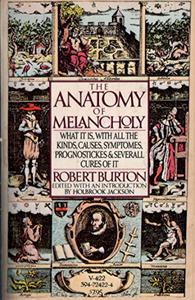
Burton, Robert, "The Anatomy of Melancholy"
English | 2016 | ISBN: 1987434528 | ASIN: B01FGRWSCE, B085RDFY7K | PDF | pages: 1568 | 4.6 mb
The Anatomy of Melancholy is one of the most remarkable books ever written.First published in 1621, and hardly ever out of print since, it is a huge, varied, idiosyncratic, entertaining and learned survey of the experience of melancholy, seen from just about every possible angle that could be imagined. Its subtitle explains much: The Anatomy of Melancholy, What it is: With All the Kinds, Causes, Symptomes, Prognostickes, and Several Cures of It. In Three Maine Partitions with their Several Sections, Members, and Subsections. Philosophically, Medicinally, Historically, Opened and Cut Up. But despite the subtitle's length, it does not do justice to the immense scope of the study. Nor to its oddness.
Robert Burton (1577-1640) was an Oxford scholar, a vicar and a mathematician with a stupendously wide reading habit which was supported by an exceptional memory: he remembered virtually everything he read. However, throughout his life he suffered from depression and was therefore able to bring personal experience to what could have been a dry, if gargantuan academic study. According to traditional medicine, accepted generally by Jacobeans, melancholy was caused by 'black bile'. But for Burton psychology underpinned all.
He divides his book into three Partitions. In 'The First Partition' he looks at causes of melancholy. He addresses diet (good and bad) and appetite; he considers witches and magicians; he surveys any number of physical maladies from 'phrenzy' to 'lycanthropia'. The soul - sensible and rational - is investigated; the passions (envy, malice, anger, discontent, covetousness, love of gaming, pride, overmuch joy) are intricately examined. 'The Second Partition' is dedicated to 'The Cure of Melancholy', and Burton discusses physical issues and social positions, while dealing meticulously with such emotional states as envy, ambition, self-love and more. 'The Third Partition' is dedicated to an examination of 'Love-Melancholy': beauty, lust, music, amorous tales, bawds - and also religious melancholy.
All this hardly reflects the experience of listening to The Anatomy of Melancholy. Burton's fertile and curious mind dips here, there and everywhere. Classical references abound; the text teems with obscure references to scientists, doctors, philosophers, writers, musicians and politicians from all ages. They are invariably fascinating and in some cases astounding. He is equally fluent in investigating the diaphragm, the pleura, the vena cava, the bladder, the gall and the spleen as he is in acknowledging the role of hypochondria and psychosomatic ailments. In one sentence he refers to the excess habits of Alcibiades, in the next he is evoking Chaucer's Wife of Bath. In fact quotations from Chaucer and Shakespeare, Juvenal, Lucretius, the Bible, Ariosto and Virgil tumble over one another in a glorious cornucopia.
Links are Interchangeable - No Password - Single Extraction



